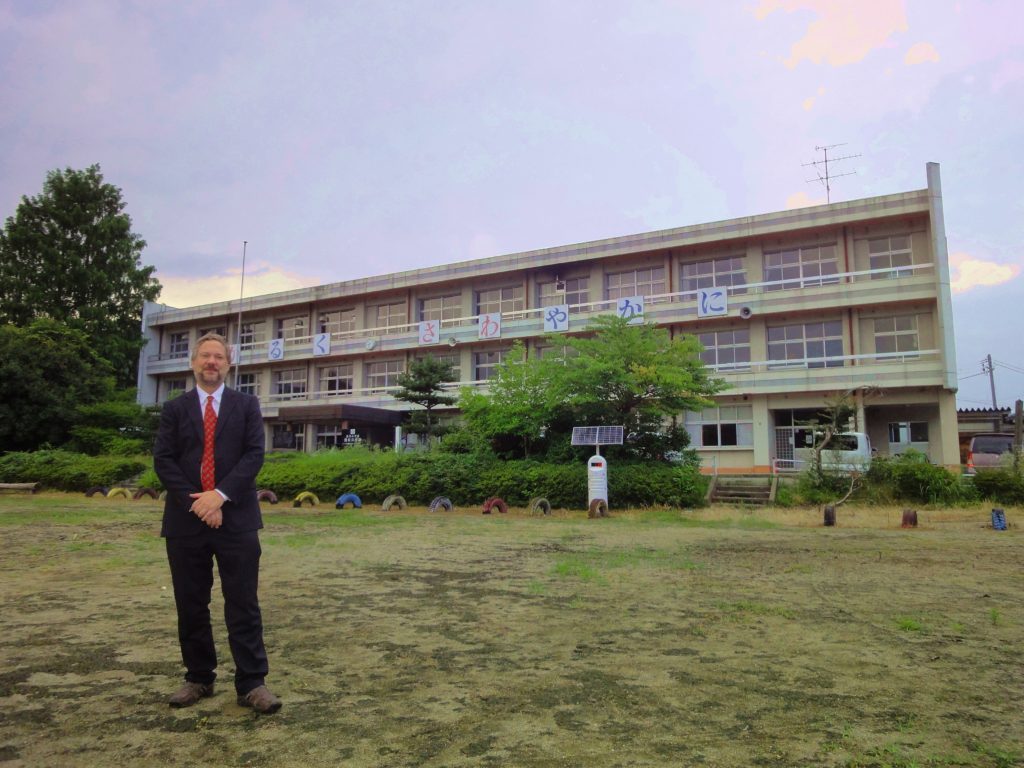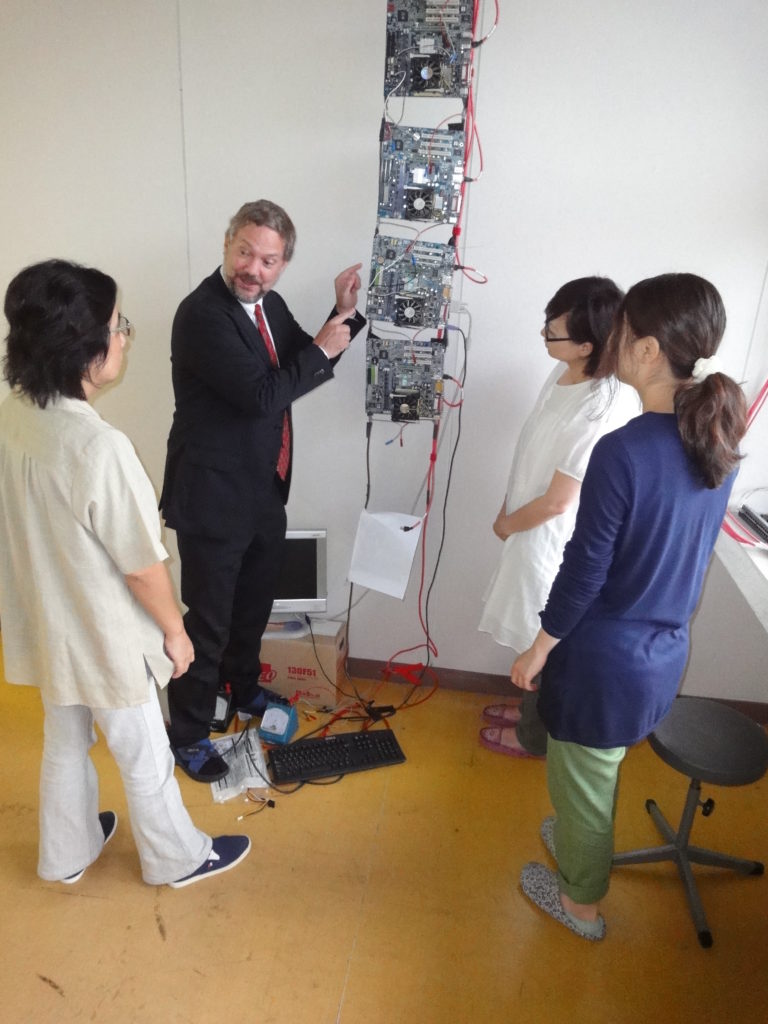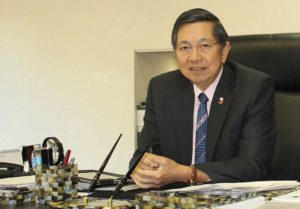Transforming Closed Schools into Data Centers in Fukushima, Japan
CONTENTS
Utilizing Abandoned School for PC Education
By Ryoji Shimada, staff writer
Nestled on a forested hillside about 100km distant from the damaged Fukushima Daiichi Nuclear Power Plant, the former Akasawa primary school in Aizumisato Town, Fukushima Prefecture, no longer resonates with the lively voices of children. Instead, a bank of computer servers emits hums from the cooling fans.
The school was closed in 2010 due to the dwindling population of young people in this town of approximately 23,000. In terms of outward appearance, the school hasn’t changed much, although now it has been revitalized for business use. Carl Sundberg, CEO of Smart Technology Partners (STP), an IT company, has transformed the unused school into a data center. His company currently employs about 30 staff members.
Data centers like STP are enjoying increased demand amid the growth in cloud computing.
“By the year 2023, I would like to increase the number of data centers to 200 throughout the country,” said Sundberg, who sees his mission as transforming ever-increasing closed schools around Japan into IT facilities, while creating jobs that will help to revitalize rural economies.
Sundberg, who is 54, first arrived in Japan at age 11, when his father was assigned to work here. After graduating from university in the US, he returned to Japan and worked for four years as an assistant language teacher under the Japanese Ministry of Education “Mombusho English Fellows” program teaching at junior high schools across all of Fukushima Prefecture. By his late 20s, he had married a Japanese woman and began working as an IT engineer at several major foreign-affiliated securities firms and financial institutions. During those years he was earning a hefty salary and resided in an upscale house in central Tokyo.
Setting up an NPO to Teach PC Skills
Sundberg eventually became skeptical of the financial industry’s profits-above-all business policy, and at the same time became concerned that rural people were not benefiting from the computer revolution. Having once worked in Fukushima, he was aware that many schools there had closed, and devised an idea to utilize them for instructing the locals in computer skills.
Armed with that idea, Sundberg visited various towns and cities in Fukushima and made proposals. At first his ideas were rejected, simply because no precedent existed. Yet Sundberg refused to allow bureaucratic inertia to discourage him. Eventually he met Hidetoshi Watanabe, the mayor of Aizumisato, who grasped his ideas and arranged for access to an unused school. In 2003, he left his position at a securities brokerage and set up an NPO, Compufarm, that offered locals a chance to learn PC skills. Sundberg worked there for about six months as a volunteer instructor, mentoring a dedicated group of volunteer instructors to teach an ever-increasing number of rural students and expand the technology curriculum of courses offered.

Sundberg standing in front of the former Akasawa primary school
He briefly rejoined the financial services industry, but then as the global economy entered a harsh recession in 2008 and he was laid off, he decided to focus instead on starting his own company, went to the US and traveled across the continent by motorcycle in search of ideas and inspiration. In the course of his wanderings, he met various kinds of people including anti-war activists, Fortune 500 CEOs and Chairmen and native American Indians. The latter, while not well off in a material sense, still maintained social and cultural cohesiveness. Influenced by these encounters, he desired all the more to become a social entrepreneur who could contribute to the betterment of society.
Social Entrepreneur Utilizing Unused Public School
The idea of converting closed schools into data centers seemed feasible, and Sundberg launched STP in 2010. Thanks to Mayor Watanabe’s support and personal connections built through Compufarm, Sundberg was offered use of the Akasawa Elementary School for his business rent-free in February, 2011. The first floor of the school building accommodated the company’s office and the servers that would store and manage clients’ data as well as offer software for on-line use.
“A school building is sturdy and spacious,” says Sundberg. “Besides, the relatively cool climate in this mountainous region is very suitable for cooling down servers.” In winter, heat generated by the servers is utilized to warm the office. On the second and the third floor is a space for conducting PC lessons for locals who might possibly work as engineers for the company in the future, in keeping with his vision of “business,” “employment” and “social education” for this project.
But then on March 11, 2011, devastation wrought by the Great East Japan Earthquake resulted in the project’s being put on hold. Since the town is located about 100km away from the damaged nuclear plants, radiation readings were low enough that the area could become an evacuation destination for the coastal villages. So the former school building was quickly returned by Sundberg to Aizumisato to accommodate some 500 evacuees for several months until they could be moved into temporary residences.
Date Center in Great Demand
Cloud computing has become a rapidly growing phenomenon. Because clients don’t have to maintain their own server, purchase and update software, and so on, this kind of outsourcing enables them to concentrate on their own business. Furthermore, one of the lessons learned from the March 11 earthquake and destructive tsunami was that resident data and other information at the hardest-hit municipal offices were vulnerable to irretrievable loss. If such data had been backed up using remote servers, it would have been retrieved more readily; recovery from the disaster would have proceeded more smoothly. The disaster thus brought cloud computing to the attention of local governments as part of their risk management strategy.

“The need for cloud computing capacity in Japan is expected to increase in a big way,” said Sundberg optimistically. “Currently much of this need is being met by cloud data centers located outside of Japan; but with the growing concerns of foreign government regulations concerning access, the demand for on-shore data centers is expected to grow even faster. We plan on building low-cost data centers, using closed schools in rural areas and implementing innovative cooling techniques. I want to establish a new business model to revitalize rural communities while sustaining the environment at the same time.”
At the moment, STP is contracted to store data for Aizumisato town, update its software and manage the related services in preparation for eventual transfer to STP’s cloud system. STP specifically started with tax filings by corporations. The system requires PDF data of the filings to be stored in a manner that enables sorting and access to the information. Once this initial project is completed, STP intends to expand the switchover to the cloud for the municipality’s other needs as well. STP has several other private clients and has been working to expand operations.
STP has plans to open data centers in other parts of Japan; but the number of schools that are closing is outstripping current demand. According to a 2012 report by the Ministry of Education, Culture, Sports, Science and Technology, 474 elementary, junior and senior high schools were closed in 2011. Between 2002 and 2011, a total of 4,222 schools were closed, an average of 422 per year. Of the total, 2,963 have been put to use as social educational facilities, gymnastic facilities, cultural centers, nursery facilities, public halls and so on, but the remainder have been effectively abandoned and every year another 100 such schools are added. Local governments and citizens are wracking their brains for ways to put these schools to use.


